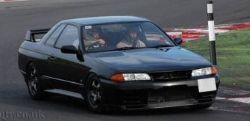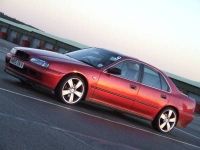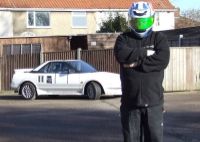I know I said I was uncomfortable to do this, and in some ways I still am, but given how popular the drift day was, the almost universally positive the feedback has been, and the general enjoyment people have told Stuart, Duncan and myself they had that night, it may well be possible that another drift night will happen or maybe more, who knows !!! Withthis in mind I thought long and hard and felt given that most of the users here are adults, and that even the few gimps we have seem relatively sensible
I know it may sound overkill above, but I am not so much concerned about the legal side of things (although perhaps I should be
Firstly a couple of bits of information about how cars drift, and the theory behind it - as I understand it myself (so may be wrong in other words
People often assume, wrongly, that a drift car requires less grip, as this makes drifting easier to acheive. Furthermore they assume the word drift relates to any motion of a vehicle when sideways, and often you get people describing how well they "drifted" a certain corner when in essence all they are doing is a classic powerslide - Tiff Needell is possibly the most high profile of people this accusation can be levelled at !!! Whilst the essence of drifting is indeed "sideways motion in a vehicle" it should more accurately be described as "Predetermined sideways motion in a vehicle round a set course using all facets of vehicle control and movement" and as such differs from Johnny Bigfoot giving a car big bananas coming out of a bend, usually after the apex, and holding the car on the power with a slight amount of opposite lock. In order to "drift" that particular corner Johnny should have set the car up long in advance of the corner in such a way that he knew he would be fully committed sideways AS HE ENTERED the corner, clipping the apex to a specified distance and usually following the racing line (or any line planned in advance) whilst extending the slide as much as possible or as far as required perhaps before the next phase of the course. In other words its pre planned and well executed tyre murder rather than well REACTIVE tyre masnlaughter that follows the way the car wants to go once a slide has happened.
This leads us to examine the other misconception I mentioned earlier that drift cars need less grip. Now you realise the whole point is not just to balance a powerslide but to pilot the car deliberately through a course to a set plan, which would you rather have to help you keep control - more grip or less ??? Thinking of it as a racing driver makes the answer easier - their task is to navigate a course as fast as possible, which obviously means more grip, well thats exactly the same for us, the moment the course is competitive then speeds increase, at which point you physically need more grip in order to not end up in the scenery and to give yourself a chance at holding the drift rather than being a passenger.
All this said and done though, as beginners it can be beneficial to have less grip to start with purely to help make the speeds at which things happen much slower so that we get a chance to notice what affects steering, throttle, brake, weight and attitude can have on the car. There are other reasons too but I wont confuse issues for now.
Hopefully most here understand some of the most basic principles in car behaviour, and one of the key areas - as Maxx was discussing in his thread - is weight distribution and its affect on grip. It has a knock on in lots of different areas such as momentum, oversteer, understeer, turn in bite and lots more besides, and hopefully as we begin to teach ourselves how to sense this weight movement within suspension and the car then we can predict more accurately what will happen in a greater range of circumstances whilst throwing the car about !!! For right now we will just simply assume the following......
Sudden throttle movements have almost no effect on weight shift
Car setup is neutral
Grip is a constant
Wet surfaces or dry make no difference
Only Rear Wheel Drive cars are being used in these examples !!
This really is going to be the most basic of starters
Lines
As a very quick generalisation for anyone who isnt used to track orientated driving, heres a few pointers about the lines you take on a track rather than the road. Nothing is coming towards you, so you use all of the available space, that means hugging the left hand whiteline or tarmac edge when coming up on a right hand bend, usually staying out later than you think before turning in, looking at the apex - which would be all the way to the right hand side of the track in this bend - (or as far as you can see round the corner) before turning in and letting your hands follow your sightline at the right moment (usually later than you think as said before !!!
This is often the same line we take in drifting, as the same principle applies. The faster you can get through the corner the more angle you would have needed to make the corner, the more control you need to keep the angle and the more smoke, attitude and impression you give the judges. It also has the benefit that the guy you twin against has to try to keep up which makes it increasingly difficult and generally speed is the thing that shows up skill more than anything else. I know that I am generalising but this meant to be simple !!!
Initiation
This is the single most important area of drifting. Its the step that determines what happens in the rest of the course, it is the first movement that makes all the rest right or wrong, good or bad. Getting this right is the key to becoming a good drifter and acheiving what the judges require on a course.
There are three main types:
Scandinavian flick
Clutch kick
Handbrake
We will go into detail about these techniques later on. Some people I know believe that you should learn these first before progressing further, some people also believe that handbrake entries are vital for beginners so they learn to balance the car quickly, but personally I dont. Whilst these techniques are what start the drift they are not the start of the control required to keep the drift and as such will be discussed later - please bear with me on this, I am only trying to help you guys in a way that makes sense to me. All I will do is describe what each one is.
Scandi flick is basically what you see on the rally stages all the time, usually from a high speed section into a slower one and gets its name from the Scandinavians who began using this technique to get the car through a corner as fast as possible on loose surfaces. In essence you steer the car quickly the opposite way to the corner you are approaching at the right moment to unsettle the car then quickly steer the way the corner is to flick the car round to face the corner and then catch the resulting slide with opposite lock and balance on the throttle through the corner. Sounds easy, takes a while to get right at anything approaching a good speed !!!
Clutch kickis my preferred choice for showing beginners how to drift as it just uses the feet and is the simplest set of movements for a driver to do while concentrating on whats going on around him. Its difficult enough to get used to the idea that you are going to throw your car around this violently with having to worry about when to start a Scandi flick or having to take a hand off the steering wheel to pull the handbrake (and remember to keep the button pushed in if it hasnt been converted for drift !!! ). In essence what you are doing is dumoing the clutch to do a burnout - just like back in the day in your XR2 at Maccy D's - except you are doing it whilst already travelling and usually whilst approaching a corner rather than in a straight line. All you do is keep your feet on the clutch and accelrator, when you are ready depress the clutch whilst maintaining or increasing the pressure on the accelerator to get the engine revs up, then when you have enough revs let the clutch out quickly (but you dont have to be too violent to begin with) and keep the throttle down or even floor it to stop the engine from bogging. This should light up the rear tyres, breaking traction, and if done whilst entering a corner should see the back end coming round nicely.
Handbrake is literally as it sounds, again another young hooligans favourite from the car parks, you are basically going to perform a moving handbrake turn. The key is doing it at the right moment, with the merest amount of steering inputs to get it swinging the right way and at a time and speed that will allow a seemless transition ionto the power to then continue and extend the drift. This use of the handbrake should not be confused with a handbrake drift which is something else again.
My fingers are a bit sore now, so Im gonna have a rest and think through what to say to actually help you rather than just talking about what it all means !!!
J.






